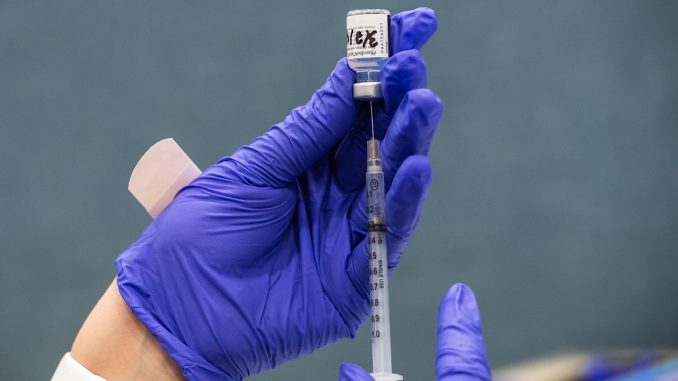
An updated COVID-19 booster that offers greater protection against the most recent variants is now available, health officials said.
The updated booster is the most recent development in the ongoing effort to combat the COVID-19 virus, nearly 2 1/2 years into the pandemic, to lower the risk of people becoming sick enough to require hospitalization or potentially die.
The Centers for Disease Control and Prevention announced last Thursday that its Advisory Committee on Immunization Practices recommended the updated booster from Pfizer-BioNTech for people ages 12 and older, and from Moderna for people ages 18 and older. The boosters add Omicron BA.4 and BA.5 spike protein components to the current vaccine composition, “targeting variants that are more transmissible and immune-evading,” according to the CDC.
“[The updated booster] can help restore protection that has waned since previous vaccination and were designed to provide broader protection against newer variants,” said CDC Director Rochelle Walensky, M.D. in a statement. “This recommendation followed a comprehensive scientific evaluation and robust scientific discussion.”
She strongly encouraged anyone eligible to receive the booster.
The CDC’s approval came one day after the U.S. Food and Drug Administration amended its emergency use authorizations for both vaccines. The FDA noted that the BA.4 and BA.5 variants are currently causing the most cases of COVID-19 in the United States and are predicted to continue circulating into the fall and winter.
Side effects from the vaccine are consistent with prior vaccines, the FDA says.
Those eligible for both the Moderna and Pfizer vaccine must be at least two months removed from completing primary vaccination or having received the most recent booster dose. The only current difference in eligibility is age.
“The COVID-19 vaccines, including boosters, continue to save countless lives and prevent the most serious outcomes (hospitalization and death) of COVID-19,” said FDA Commissioner Robert Califf, M.D. in a statement last week. “As we head into fall and begin to spend more time indoors, we strongly encourage anyone who is eligible to consider receiving a booster dose with a bivalent COVID-19 vaccine to provide better protection against currently circulating variants.”
The vaccination effort against COVID-19 began in December 2020 and became widespread across the country in throughout 2021. New variants of the virus, starting with the Delta variant in the summer of 2021 and then Omicron in the fall of 2021, have proven more effective at evading vaccines, meaning vaccinated people have still become infected. But health officials say the vaccines remain effective at limiting the severity of the disease.
“It is vital that we take advantage of the latest tools and resources at our disposal in order to keep ourselves and our loved ones safe and healthy,” Gov. Kathy Hochul said last week. “As we prepare for potential fall surges, I encourage New Yorkers to stay up to date on vaccines and remain vigilant.”
Cases of COVID-19 in Suffolk County have remained largely steady since spring. Cases per 100,000 peaked at 57.7 on a seven-day average in late May and currently stand at 23.1. Data is somewhat limited, however, with the widespread of availability of at-home tests leading to fewer reported cases.
The hospitalization figures across Long Island also remain steady since spring and are a key indicator. The numbers began to rise in mid-April into May and as many as 516 people were hospitalized on July 19, according to data from the New York State Department of Health. That number has dropped to 404 at the start of September.
The fall of 2020 and 2021 both saw the start of COVID surges that peaked in early January. Officials are optimistic current vaccination levels and the new booster can limit a similar surge this fall into winter.
The state DOH cites CDC data from the Omicron surge that shows those who were boosted were 21 times less likely to die from COVID-19 compared to those who were unvaccinated and seven-times less likely to be hospitalized.
Vaccines are available to anyone ages 6 months or older and are widely available at pharmacies, local health departments, clinics and other facilities. For assistance, visit vaccines.gov/search. The vaccination rate in the youngest age group from 0-4 years old remains minuscule at just 6.4% having received one dose. Less than half of children ages 5-11 have received one dose at 43.8% across the state.
Less than half of eligible residents in New York ages 54 of younger have received at least one booster. The first age group to go above 50% is ages 55-64 at 57.7%. Nearly 74% of residents ages 65-74 have received at least one booster.
For more information, visit coronavirus.health.ny.gov.

